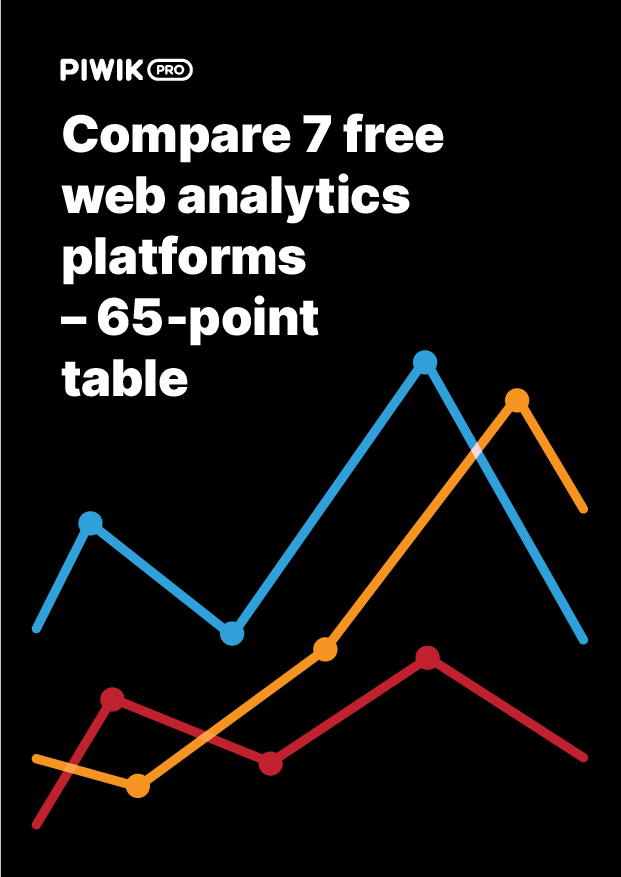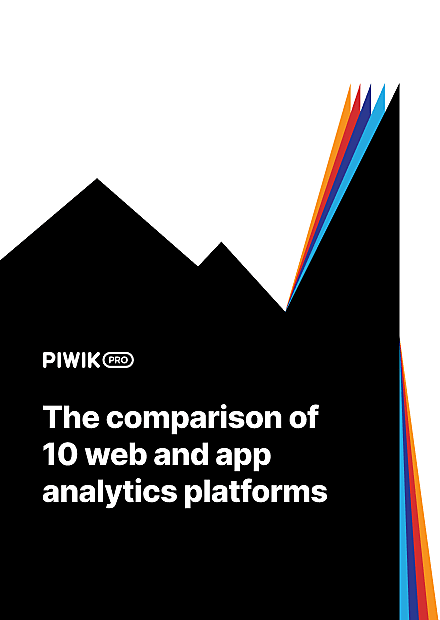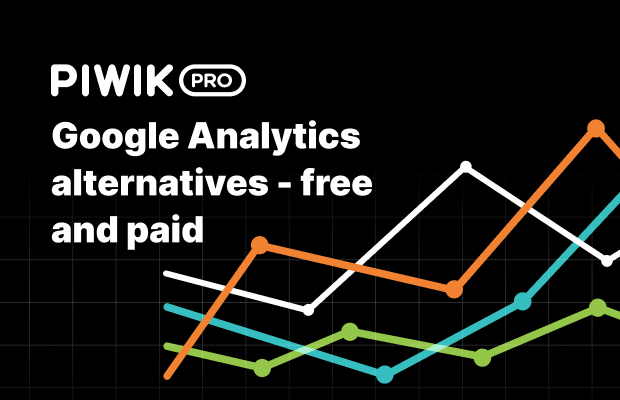The free Core plan will transition to the Business plan in December 2025. Visit our pricing page for more details about the available plans.
Universal Analytics was a mature, versatile piece of analytics software that fulfilled many needs. Users appreciated how easy to navigate it was, along with its useful reporting features.
But the days of UA are gone – companies who opt to continue using Google’s analytics tools need to transition to GA4, which is a highly complex tool with a steep learning curve.
Luckily, you don’t have to settle for GA4. You might want to consider switching to one of the alternative analytics platforms for many reasons:
- The need for costly and time-consuming GA4 workarounds in GA4, such as BigQuery configuration
- Lack of many basic features and reports available by default
- Data sampling
- Lack of data control and transparency
- The inability to onboard PII to GA4
- Limited data retention
- Lack of GDPR or HIPAA compliance
- No personalized training or support
- No ability to choose data hosting
In this article we’ll go through the top free Google Analytics alternatives. We deliberately avoid platforms that only offer a limited trial period. Because web analytics projects can grow in volume, we also look at the paid versions. That’s why we focus on Piwik PRO, Matomo, Countly, Mixpanel, Woopra and Google Analytics.
GA4 auto migration process
GA4 auto migration process
On February 9, 2023 Google said they would start configuring Google Analytics 4 for users in March 2023.
This means that if you have a Universal Analytics (UA) property but haven’t migrated to GA4, Google will create a GA4 property based on many of the settings you have in UA, such as your goals, audiences, Ads links, users, and more. Moreover, even if you have already set up GA4, you might still be subject to auto migration.
Read more on GA4 auto migration in GA4 migration problems: What are the alternatives
Free alternatives to Google Analytics
Free web analytics platforms always have limitations, be it reduced performance, lack of solid privacy features or sampled data. Still, a free web analytics platform can help you run your projects successfully. You just need to make an informed decision and choose the platform whose limitations will affect your projects as little as possible.
Think about the goals of your projects, both short- and long-term. Some platforms ensure an easy transition from free to paid and more advanced versions. They also let you, for example, keep the setup, data, tags, etc. so you don’t have to start from scratch. Others just eliminate the limitations and lift the price.
The compromises and limitations you can accept depend on your project. We want to present you with all the information on free Google Analytics alternatives you need to make an informed decision.
Here you will find basic overview of seven free platforms:
| Performance and features | Functionality compared to the paid version | Data protection and security | Action limit | |
|---|---|---|---|---|
| Google Universal Analytics (GA3) | good | 10 million | ||
| Google Analytics 4 (GA4) | good | none | ||
| Piwik PRO Core | good | 500 thousand | ||
| Matomo On-premises | very limited | depending the on server | ||
| Countly Community | very limited | depending the on server | ||
| Mixpanel | good | 100 thousand | ||
| Woopra | acceptable | 500 thousand |
Four of these platforms provide many of the analytics features of the paid plans, so with some projects you could just stick to those free versions. Even if it turns out that it’s not enough, getting started with a free platform will help you realize what you’ll need for future, more challenging analytics projects.
Experts opinion
Daniel Bensason
As with any important decision you take, it’s always important to weigh out your options. That’s why everyone should consider a free alternative to GA4. Working agile, as we do at Liip, means staying curious and questioning existing processes and tools in place. We have many partners using GA4 who switched from UA without wondering if it was the right tool for their needs. GA4 is lacking in a few key aspects but the most important characteristic of any analytics tool is its ease of use. GA4 is difficult to use, so I would not recommend GA4 to organizations with basic reporting needs and no analytics experience – it is simply too complicated.
Figure out which functionalities you like in your current tool and evaluate tools based on them. I would create 3 categories of characteristics: performance, privacy and price. Performance refers to your needs for custom dimensions, the number of domains to report on, access to raw data, data import and export, and others. Privacy depends on whether you need to be compliant with data protection laws, how the platforms collect cookies and how easy it is to delete data. Though the price aspect seems obvious, many tools have different pricing models and hidden costs, so it is important to define a budget from the beginning.
Piwik PRO’S Migration tool (GA3 and GTM)
The migration tool lets you quickly transfer your settings from Google Analytics 3 (Universal Analytics) and Google Tag Manager. It enables you to import GA3 properties, settings, goals, custom dimensions, and Google Tag Manager containers, including tags, triggers, and variables.
What free Google Analytics alternatives offer
Let’s start with the most important features:
| Access to raw data | Integrated consent manager | Integrated tag manager | |
|---|---|---|---|
| Google Universal Analytics (GA3) | |||
| Google Analytics 4 (GA4) | |||
| Piwik PRO Core | |||
| Matomo On-premises | |||
| Countly Community | |||
| Mixpanel | |||
| Woopra |
A tag manager, consent manager, and access to raw data give you a robust foundation of your analytics projects. In case you hit action limits and your project outgrows the free platform, you just keep running on the paid plan.
Moreover, data quality is an important aspect:
| Data timeliness | Data storage | Data sampling | |
|---|---|---|---|
| Google Universal Analytics (GA3) | 24 – 48 hours | standard 26 months, user-defined | automatic sampling for more than 500 thousand sessions per month |
| Google Analytics 4 (GA4) | 4 – 8 hours | 2 or 14 months | standard and advanced reports(after 10M hits) |
| Piwik PRO Core | 30 min | 14 months | |
| Matomo On-premises | 15 min | custom | |
| Countly Community | 1 hour | custom | |
| Mixpanel | real-time | 60 months (accessible only 90 days in the free version) | |
| Woopra | n/a | 90 days |
Although Google Analytics has fewer action limits, or no limits at all in the case of GA4, it samples the data. In some scenarios, it won’t be a big problem. However, sampling will hurt the accuracy of your data and reports.
Get more detail about data sampling: What are the causes of data discrepancies between Piwik PRO and other analytics platforms?
Now, let’s look at reporting features. If you work with raw data it might take a while to do in-depth analysis. That’s why it’s crucial to have customizable reports that will save you a lot of time.
| Conversion funnel | User flow report | User-level reports | Multi-channel attribution | |
|---|---|---|---|---|
| Google Universal Analytics (GA3) | ||||
| Google Analytics 4 (GA4) | ||||
| Piwik PRO Core | ||||
| Matomo On-premises | paid plugin | paid plugin | paid plugin | |
| Countly Community | ||||
| Mixpanel | ||||
| Woopra |
Experts opinion
Pat Barry
Types of businesses that should consider an alternative to GA4 include:
- Businesses within heavily regulated industries like healthcare and finance. They need to follow regulations like HIPAA and various regulatory best practices for financial data.
- Businesses that want to see raw data as opposed to the sampled data that GA4 models out.
- Businesses with employees exposed to web analytics for the first time. You need a strong knowledge of BigQuery or knowledge of how to operate a data warehouse to operate GA4 properly.
On-prem analytics is an example of a better GA4 alternative. An on-prem solution allows business owners to store their data themselves, which does not necessitate signing a BAA with the web analytics provider. The downside of an on-prem web analytics platform is that you need a very strong data and development team to maintain it.
When my team helps clients vet web analytics platforms, we break down the criteria into three buckets: price, security and features. Features are further divided into ease of use (for example, reporting customization options and creating custom metrics and dimensions) and integrations (for example, media tracking, tag management solution, and heatmapping).

read also
Get your analytics project off to the right start and compare seven free web analytics platforms.
Download the full 65-point comparison (direct link, no form to fill out).
Paid alternatives to Google Analytics
Paid alternatives to Google Analytics overcome the limits of their free forerunners and grant more options for data collection and analysis. This includes the performance of the analytics platform, data protection, and extensive customer support.
Here’s the overview:
| Performance and features | Data protection and security | Customer service | |
|---|---|---|---|
| Google Analytics | self-service | ||
| Google Analytics 360 | SLA, community, self-service, and general support | ||
| Google Analytics 4 360 | SLA, community, self-service, and general support | ||
| Piwik PRO Enterprise | SLA, community, self-service, personalized implementation, dedicated support specialist, 2nd level technical support, custom add-ons | ||
| Matomo Cloud | email support, self-service | ||
| Countly Enterprise | community, self-service, email support | ||
| Mixpanel | community, self-service, email support | ||
| Woopra | community, self-service, support depending on contract starts from $ 999/month |
Each platform, as with the free version, gives you different features and services to fit your specific use case. Look for platforms that can scale – those that can easily support an ever-growing project.
Flexibility of a Google Analytics alternative
Google Analytics users often face limitations they would like to overcome – be it in the area of data protection or detailed customer segmentation based on user-level data. Here, organizations want flexible alternatives that meet their unique high-end requirements.
Also, an important aspect of those platforms is the way they store data.
| Cloud | Private cloud | On-premises | |
|---|---|---|---|
| Google Analytics (GA3 & GA4) | |||
| Google Analytics 360 (GA3 & GA4) | |||
| Piwik PRO Enterprise | |||
| Matomo Cloud | |||
| Countly Enterprise | |||
| Mixpanel | |||
| Woopra |
For many organizations, the standard data safeguards of public clouds are sufficient. However, those operating in jurisdictions with strict data privacy regulation or highly regulated industries, for instance, in finance or healthcare, might require a private cloud. In addition, multiple server locations give you more flexibility to work with data where you want.
Learn more about data storage options in our article: How to host your analytics: public cloud vs private cloud vs self-hosted.
Discussing the basis of privacy-compliant analytics, you can’t forget about the data itself. As with the free Google Analytics alternatives, data quality also plays a role in enterprise plans.
| Data timeliness | Data sampling | Data storage | Access to raw data | |
|---|---|---|---|---|
| Google Analytics | 24-48 h | 2 or 14 months | ||
| Google Analytics 360 | guaranteed by the SLA 4 h | unlimited | ||
| Google Analytics 4 360 | 1h | unlimited | ||
| Piwik PRO Enterprise | 30 min | 25 months (more possible on request) | ||
| Matomo Cloud | 15 min | 6-24 months | ||
| Countly Enterprise | 1 hr | custom | ||
| Mixpanel | real-time | 60 months | ||
| Woopra | n/a | 24 months |
Google Analytics 360 also samples data. In some situations, this makes it difficult to reproduce results and analyze data accurately.
Learn more about sampling and other issues with GA4 in our article 6 key Google Analytics limitations.
Experts opinion
Sara Gøttsche
I meet many organizations, large and small, who find the transition from Universal Analytics to Google Analytics 4 difficult because of the steep learning curve. This often means a lot of frustration as the data that users could easily access in UA is suddenly not easily available in GA4.
Organizations that have not previously used a paid analytics tool such as Google Analytics 360 are not used to paying for storing their data. Analytics might not be included in their marketing budgets, so it makes sense for them to consider a free alternative to GA4. Most free tools also offer a paid version, which often means that the free version is limited. Therefore, you need to evaluate whether you can comply with the limitations of the free version.
You should consider a free alternative to GA4 if:
- You are not satisfied with your current analytics tool.
- You do not wish to pay for an analytics tool if possible.
- The amount of monthly hits on your website matches the thresholds of the free analytics tools.
- You want a tool that isn’t time-consuming to learn how to use.
- You want an analytics tool with more standard reports than GA4.
- You want a mature analytics tool.
- You find it challenging to migrate from UA to GA4.
- You want to control where your data is stored.
Consider making a list of the pros and cons of your existing analytics system so features that work well are at least possible in the GA4 alternative. Then, think about what you would like to use your analytics tool for in the future. For example, if you want to use other marketing channels, investigate how the tool works with them. If you want to set up dashboards, check which integrations are possible with the new analytics platform.
To define your needs, ask yourself the following questions:
- How many monthly hits do we have?
- Where do we want to store our data?
- Which privacy laws do we need to comply with? Does the tool let us comply with these laws?
- Are there features that are necessary for us?
- Do we want a consent manager, tag manager and analytics in the same tool?
- Do we need access to raw data?
- Do we need data freshness? What requirements do we have for data freshness in our reporting?
- What reporting requirements do we have for conversion funnels, user flow reports, user-level reports and multi-channel attribution?
- Do we already have or want to get a dashboard?
- Which integrations are necessary to get the best possible tracking setup for us?
In some cases, GA4 and GA4 360 lack features that alternatives can offer, such as:
- How often data is collected. With GA4, it can take up to 48 hours before all data is available in your reports. This is faster with GA4 360, where data is downloaded once an hour. However, several alternatives offer much faster data updates, such as every half hour, every 15 minutes, or even real-time. Add to this the ability to access raw data which is not an option with GA4. GA4 360 lets you access raw data via BigQuery, but many alternatives offer raw data access without a plugin or BigQuery integration.
- Hosting options. GA4 and GA4 360 are only offered as a cloud solution. This means you have no control over data location. At a time when there is a lot of focus on data protection and security, especially in European countries, the location of the data center is important.
- The possibility to combine analytics with other tools. Some GA4 alternatives also offer a consent manager in the same system as analytics. With some options, you can even combine both a consent manager and tag manager from the same vendor.
Integrations of Google Analytics alternatives
As mentioned earlier, Google Ads and Google Search Console enrich your data set. So, let’s have a look at these integrations first:
| Google Ads | Google Search Console | Create reports via API | |
|---|---|---|---|
| Google Analytics | |||
| Google Analytics 360 | |||
| Piwik PRO Enterprise | |||
| Matomo Cloud | |||
| Countly Enterprise | |||
| Mixpanel | |||
| Woopra |
APIs enable automated and efficient reporting. A set of logs extracts structured data from your analytics software into custom scripts or programs.
But what about in-depth analysis that requires processing user-level data? Integrations with BI tools, CRMs, and CDPs are an important factor in detailed analyses.
| Integration with BI tools | Export/import of user-level data | CDP integration | Custom integrations | |
|---|---|---|---|---|
| Google Analytics | ||||
| Google Analytics 360 | ||||
| Piwik PRO Enterprise | ||||
| Matomo Cloud | ||||
| Countly Enterprise | ||||
| Mixpanel | ||||
| Woopra |
Analytics vendors ensure a variety of ready-made integrations. For specific use cases, a good analytics partner will set up custom integrations to connect the existing MarTech stack.

COMPARISON
The comparison of 10 web and app analytics platforms
Learn the key differences between Piwik PRO Enterprise, Google Analytics 4, Matomo Cloud, Adobe Analytics, AT Internet, Countly Enterprise, Mixpanel Enterprise, Amplitude Enterprise, Snowplow Enterprise, and Heap Premier.
EU-based Google Analytics alternatives
Since the Austrian data protection authority (DPA) released its statement about the unlawfulness of using Google Analytics within the EU, more European DPAs – such as Norway, Italy, and Denmark – have issued similar opinions.
What does this mean for your organization? Processing the personal data of EU residents when using Google Analytics might be a breach of the GDPR. That means it may be time to consider a European-based Google Analytics alternative.
Learn more about Google Analytics and data privacy: Is Google Analytics GDPR-compliant?
We’ve prepared a selection of providers from different EU countries for you and focused on analytics capabilities and privacy compliance.
Most Google Analytics alternatives provide an easy-to-use user interface. Some analytics vendors collect only non-personal data and concentrate on behavioral data. However, combining user-level data and anonymous data gives the insights you need for in-depth analysis.
Let’s take a look at the table below.
| Country | Analytics capabilities | Free version | Privacy friendliness | |
|---|---|---|---|---|
| Piwik PRO | Poland | (complies with CNIL’s guidelines for consent exemption, offers anonymous data collection under TTDSG/TDDDG and high level of anonymization) | ||
| Simple Analytics | Netherlands | |||
| Hotjar | Malta | |||
| Statcounter | Ireland | |||
| Plausible | Estonia | |||
| Pirsch | Germany | |||
| Friendly Analytics | Switzerland | |||
| Splitbee | Austria |
The GDPR states that transfer to another country is only allowed when the same level of data security is met. That’s why we looked at data residency as well.
| Cloud data residency | Private cloud residency | On-premises residency | |
|---|---|---|---|
| Piwik PRO | selected data center: Germany, the Netherlands, Sweden, France, the US or Hong Kong | selected data center: one of 60+ Azure regions, and Elastx | |
| Simple Analytics | Netherlands | ||
| Hotjar | AWS in Ireland | ||
| Statcounter | Depends on your location or cloud service you choose | ||
| Plausible | Germany | ||
| Pirsch | Depends on your location or cloud service you choose | ||
| Friendly Analytics | Switzerland and Germany | ||
| Splitbee | Depends on your location or cloud service you choose |
Why privacy compliance is a must-have
Google Analytics makes it challenging to collect data in line with data protection regulations.
Despite changes in privacy settings compared to UA, such as introducing consent mode, GA4 still collects personal data and processes it outside the EU. While this is the most pressing privacy issue with Google Analytics, it’s not the only one. Google also uses visitor data for its purposes and doesn’t let you choose where your data is stored.
This is where alternatives come in handy. They provide you with privacy features you need to comply with regulations and obtain the data you want.
Once a company or organization is aligned with the rules laid out by the GDPR, they get more options to collect data. That means gaining a competitive advantage, building trust with consumers, and creating new marketing opportunities.
Moreover, better privacy protection lets companies collect and analyze post-login areas that often contain sensitive – and more valuable – information about customers. Those can only be tracked by an analytics platform that handles such data appropriately.
Learn about different tracking methods that allow you to gather such data and work with privacy regulations: 6 ways analytics software collects data online – plus a comparison of 5 popular platforms.
Google Analytics alternatives – final thoughts
We hope you now have a decent overview of your options. You don’t have to go for GA4 just because it is the most common choice. There are many platforms out there that fill in the gaps created by GA4.
Piwik PRO gives you full control over your data and its use, offers safe hosting options, and helps you comply with privacy regulations like GDPR and HIPAA. It doesn’t sample data by default, and it gives you a wide range of retention options and dedicated customer support (in the Enterprise plan).
If you want to learn more about how Piwik PRO compares to other analytics platforms, check out our materials:
Piwik PRO vs Google Analytics →
Piwik PRO vs. Google Analytics 360 →
Piwik PRO vs. Matomo →
Piwik PRO vs Adobe Analytics →
This comparison is based on the publicly available information gathered in January 2022.















